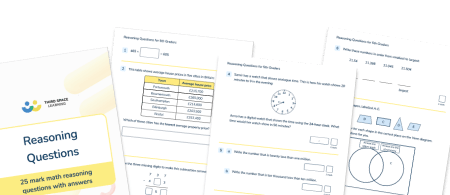35 Math Questions For 5th Graders: Answers With Worked Examples
In 5th grade math, the toughest questions are often the reasoning questions. In this article, we’ve put together a collection of math questions for 5th graders, organized by the different kinds of reasoning questions that students may encounter on standardized tests and beyond.
Why focus on math reasoning questions?
Most fifth graders find reasoning questions to be the most difficult. Unsurprisingly, we teach thousands of students in the weeks leading up to standardized tests. Teaching them math reasoning skills at the elementary level is a big part of what we do here at Third Space Learning.
We even recently made the decision to restructure our elementary lessons to introduce math reasoning questions earlier in their learning journey as the difficulty level was just too high at the end of the lesson. We definitely feel fifth grade teachers’ pain!
Whatever level your students are currently achieving in math, math reasoning questions will appear from elementary to high school, so it is an essential skill for the future.
If you find you have children in your class with a lot more catching up to do than others, then we may be able to support them with some personalized one-on-one tutoring if you get in touch.
Reasoning Questions for 5th Grade
Looking to help your 5th grade students to develop reasoning skills? Our reasoning questions cover a range of 5th grade math content, including addition and subtraction, place value and decimals. Includes helpful answer key and additional guidance for teachers.
Download Free Now!35 math questions for 5th graders
There are 7 types of math reasoning questions that fifth graders are likely to encounter:
For each of these types we’ll examine an example problem, looking at the question, the correct answer, and how to go about answering this problem.
We’ll also look at further examples of each type of math reasoning question and answer, again with worked examples and an explanation of how to answer each.
Our aim is to provide you with a sample of the types of math reasoning questions and how to teach the reasoning and problem solving skills they’ll need to solve them.
For more word problems like this, check out our collection of 2-step and multi-step word problems. For advice on how to teach children to solve problems like this, check out these math problem solving strategies.
Math Question Type 1: Single step word problems
The simplest type of reasoning question students are likely to encounter, single step problems are exactly that: students are asked to interpret a written question and carry out a single mathematical step to solve it.
Take a look at the question below:
Reasoning Question 1

Answer: $0.65
A relatively easy question to interpret–the first step will be to rewrite the amounts given so that they can properly line up the place values in order to solve. From here the simple mathematical step is subtraction i.e. $2.00 – $1.35 = 0.65.
The most crucial skill for grade schoolers in this question is a solid understanding of money as relating to place value. If this understanding is present, the mathematical step itself is quite easy.
Below are several more examples:
Reasoning Question 2
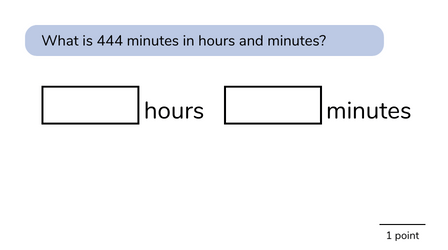
Answer: 7 hours 24 minutes
Students need to understand that one hour is equal to 60 minutes. From here the single mathematical step is division: 444/60, to find a whole number answer with a remainder.
Reasoning Question 3

Answer: 48 cm3
Students must multiply length by width by height, using the amounts provided by the question.
Reasoning Question 4

Answer: 1,488 cubic cm
A simple enough calculation (multiplying) if students are aware that the volume of a rectangular prism can be found by multiplying the area of the base by the height.
Reasoning Question 5
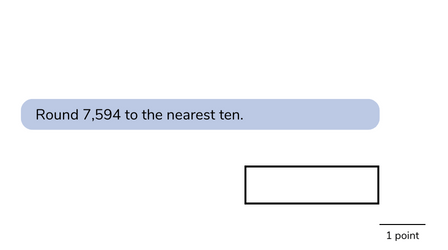
Answer: 7,590
A single, relatively simple rounding problem – students should recognize that ’94’ is the place they should focus on for this problem.
Math Question Type 2: Multiple step worded problems
A more complex version of the single step word problem, multi-step problems require students to interpret a written problem, but solving it then requires the use of two or three math skills.
For example, consider this question below:
Reasoning Question 1

Answer: $1.85
This question encompasses three different math skills: multiplying (and dividing) decimals, addition and subtraction. Students can choose to work out the multiplication or division first, but must complete both before moving on.
Once these values have been worked out the next steps are relatively simple – adding the two values together, and subtracting the total from $5.
Multi-step problems are particularly valuable to include in practice tests because they require children to apply their knowledge of math language and their reasoning skills several times across the course of a single question, usually in slightly different contexts.
More examples:
Reasoning Question 2

Answer: $5,520
There are two steps to this problem, but both are multiplication. The first is to work out how much money is made per day – 92 x $15. This product is then multiplied by 4 – the number of days – to get to the answer.
Reasoning Question 3

Answer: 1360 miles
Another two step problem. The first step is to work out 4 of 3,400 miles. Then divide this by 10 to solve for 4/10 of 3,400.
Reasoning Question 4

Answer: $153
There are four steps involved in solving this problem: multiplication (doubling $51), division (dividing $51 in half), multiplication again (doubling half of $51–which some students may recognize those last two steps were unnecessary as that brings us back to $51), and addition (putting the two costs together).
Given the number of steps involved it can be easy for students to make arithmetic mistakes.
Reasoning Question 5

Answer: 11.45 lbs
A two-step problem again: multiplying 3.45 lbs by 4, then subtracting 2.35 lbs from the total.
Math Question Type 3: Problems involving measurements
As their name suggests, these questions ask students to solve a problem that includes one or more units of measurement.

Reasoning Question 1

Answer: 40 washes
This is a two step problem; students must first be able to read and convert kilograms to grams (and therefore know the relationship and conversions between the two units- 1,000 grams to 1 kilogram), multiply 2.6 by 1,000 which equals 2,600, then divide 2,600 by 65. The quotient is the number of washes possible.
Further examples:
Reasoning Question 2
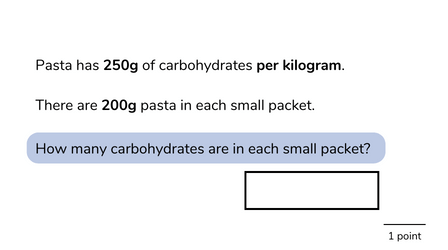
Answer: 50g
A relatively simple division problem, relying on students having knowledge that 200g is one fifth of a kilogram.
Reasoning Question 3
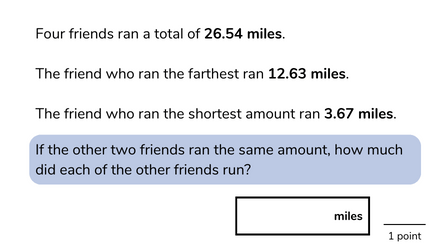
Answer: 5.12 miles
Another three step problem, and this requires students to subtract and divide decimals – subtracting 12.63 miles from the total amount, taking the difference, 13.91, and subtracting 3.67 miles, and then dividing that difference, 10.24, in half to obtain the distance the other two friends ran.
Reasoning Question 4

Answer: 84 inches/7 foot
To find 8 feet in inches, students must multiply 8 by 12. This gives the answer 96 inches. Students must then divide 96 by 40 to find the height of one box: 2.4 inches. Multiply 2.4 by 5 and minus this from the original 96 inch tower.
Interesting to note that the units for the answer may or may not be specified – an answer given in inches or feet will be accepted, however sometimes the unit will be specified in the answer box. This is why we encourage students to keep an eye on whether units are provided in the answer box.
Reasoning Question 5

Answer: 0.05 lbs
As with the running question there are three steps involved to solve this problem: subtracting the heaviest car from the total amount (3.85 – 1), figuring out the weight of the remaining three cars (2.85/3) and subtracting 0.95 from 1 to get the remaining amount of 0.05 lbs.
Question Type 4: Problems involving drawing
Problems involving drawing require students to construct an accurate drawing by following a set of instructions, or through reflection, translation, or scaling.
Reasoning Question 1

Answer: Any pair of lines that make a square of 4 units, a rectangle of 6 units, and a square of 25 units.
This question is considerably more complex than it appears, and incorporates aspects of multiplication as well as spatial awareness. One potential solution is to work out the area of the card (35), then work out the possible square numbers that will fit in (understanding that square numbers produce a square when drawn out as on a grid), and which then leave a single rectangle behind.
A lot of work for a single point!
Some further examples:
Reasoning Question 2
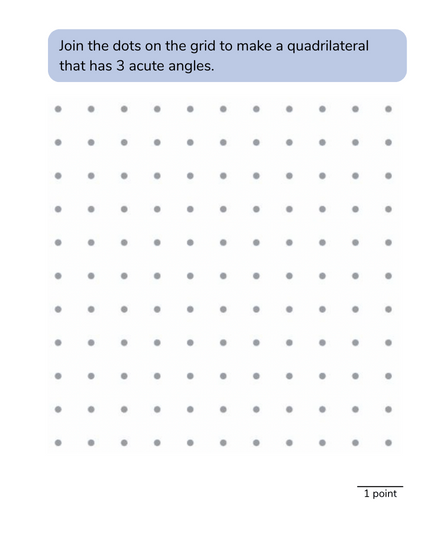
Answer: Any quadrilateral made by joining the dots that has 3 acute angles e.g. an arrowhead shape.
Reasoning Question 3

Answer: An accurately drawn angle.
This question demands students to have an understanding of and ability to accurately use a protractor. Often, a mark scheme allows some room for error – “between 34 and 36 degrees” is acceptable.
Reasoning Question 4

Answer: An accurately drawn angle.
As with the question above, a small amount of room for error is given as it acceptable to be between 139 and 141 degrees.
Reasoning Question 5

Answer: Points drawn at (2,1), (5,1) and (2,4).
Math Question Type 5: Explanation questions
These problems ask children to explain a mathematical statement or error.
As an example:
Reasoning Question 1

Answer: If the distance from P to R is 800 yards and the distance from P to Q is (Q -> R x 4), it must be 4/5 of 800 = 640 yards. Therefore Olivia is wrong.
More than most problems, this type requires students to actively demonstrate their reasoning skills as well as their mathematical ones. Here students must articulate either in words or (where possible) numerically that they understand that Q to R is 1/5 of the total, that therefore P to Q is 4/5 of the total distance, and then calculate what this is via division and multiplication.
Further examples below:
Reasoning Question 2

Answer: No, 2/100 is the same as 2 divided by 100, which equals 0.02.
Reasoning Question 3
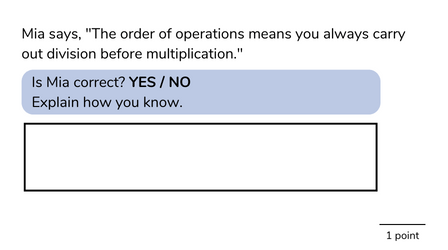
Answer: No; multiplication and division have the same priority in the order of operations, so in a problem like 40 x 6 ÷2, you would carry out the multiplication first as it occurs first.
Reasoning Question 4

Answer: No
Any explanation that provides a counter-example is acceptable e.g. “Not if the number is 1”, “Not for 0,” “Not if the number is less than 1” etc.
Reasoning Question 5

Answer: Any answer that refers to the fact that there is a 5 in the hundredths place, AND a 9 in the thousandths place, so that the number has to be rounded up as far as the ten-thousands place.
Math Question Type 6: Sequence questions
Another relatively simple kind of reasoning question, sequence problems involve students completing mathematical sequences.
Consider this example:
Reasoning Question 1

Answer: 35, 42, 49, 56, 63, 70
The question’s instructions point clearly to the solution: figure out what the increase between numbers is, then apply this via addition or subtraction to find the missing numbers.
Higher achieving students might quickly pick up that this is in fact the 7 times table and rely on their knowledge of multiplication facts to obtain the answer – this should be encouraged so long as they then check their answer in the normal method to ensure they haven’t made a mistake.
More examples:
Reasoning Question 2

Answer(s): 8/8 or 1 and 2 1/8 (OR 17/8)
Both answers must be correct to receive the point. Students must recognize that 3/4 is the same as 6/8, so the sequence is increasing in 3/8 each time. The first number is 3/8 less than 1 3/8 and the final number is 3/8 greater than 1 3/4. They then must be able to add and subtract fractions to obtain the answers.
Reasoning Question 3

Answer(s): 4.2 and 7
Reasoning Question 4

Answer(s): 128, 135 and 156.
Reasoning Question 5
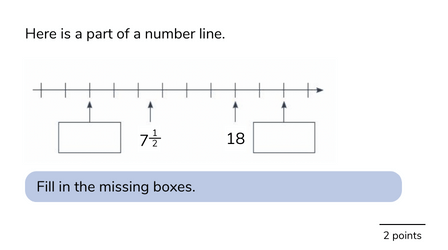
Answer(s): 0 and 24
This number line question can be a little tricky; students need to figure out that the marks on the line represent increments of 3, and count backwards and forwards in 3’s to obtain the missing numbers.
Math Question Type 7: Ordering questions
A slightly more complex variation of the sequence question, ordering problems require students to put a set of numbers, fractions or measures in the correct order.
A good example is this fifth grade math question below:
Reasoning Question 1

Answer: 3/5, 3/4, 6/5
This question throws a wrench in things by including an improper fraction, but this is hardly unusual. These sorts of questions are just the place to find other ‘curveballs’ such as equivalent fractions, mixed numbers, decimal numbers, and fractions all mixed into one problem.
A good knowledge of the fundamentals of fractions is essential here: students must understand what a larger denominator means, and the significance of a fraction with a numerator greater than its denominator.
Further examples:
Reasoning Question 2

Answer: D,C,A,B
Encourage students to convert all the fractions to one denominator value to make ordering easier.
Reasoning Question 3
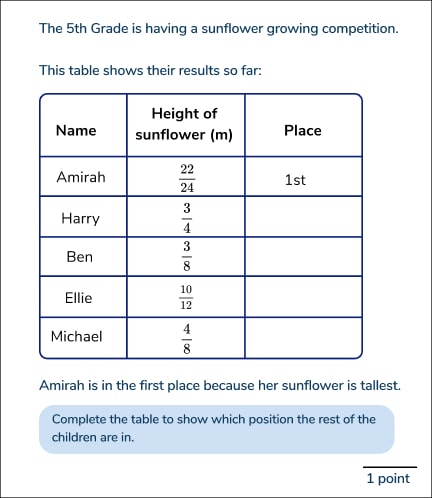
Answer: (descending down the ‘Place’ column) 3rd, 5th, 2nd, 4th
Students could use many strategies to solve this problem. The most time consuming would be to rewrite all the fractions with a common denominator. More efficient strategies would include reasoning about the size of the fractions in comparison to ½ or 1. For instance, a student may notice that ⅜ is the only fraction less than ½, putting Ben in 5th place. 4/8 is exactly ½ whereas the others are greater than ½, putting Michael in 4th place. Then the student may recognize that 10/12 is closer to 1 than ¾, completing the rest of the table.
Reasoning Question 4

Answer: C, B, D, A
Reasoning Question 5
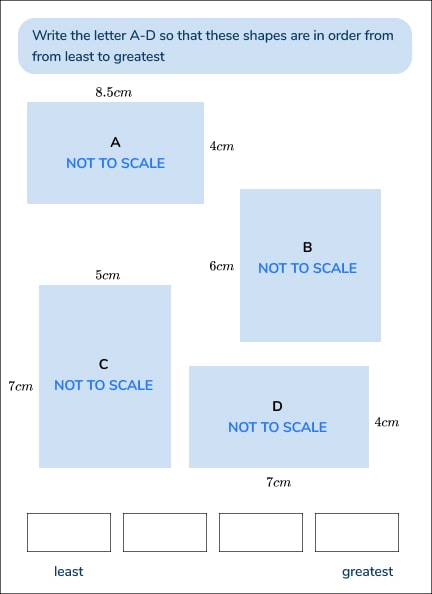
Answer: D, A, C, B
7 Top Tips For Answering 5th Grade Math Reasoning Questions
Now that we’ve covered how to answer some specific types of reasoning questions, here are some more generic tips for success in standardized tests. They may not all be applicable to every single question, but will apply to at least two, usually more.
- Get students in the habit of identifying what information they’re given in a question, and what they need to know to solve the problem. This helps them start to form the steps needed to find the solution.
- Ask students to ‘spot the math’ in a question – which operations or skills do they actually need to use to solve the problem? This is useful even for arithmetic questions – it’s no surprise how often children can misread a question.
- Check the units! Especially in questions involving multiple measures, it can be easy to give the answer in the wrong one. The answer box might give a specific unit of measurement, so students should work to give their answer in that unit.
- In a similar vein, remind students to convert different units of measurement in a question into the same unit to make calculations easier e.g. lbs to oz.
- Encourage numerical answers where possible. Even in explanation questions demonstrating the mathematical equation is a better explanation than trying to write it out.
- The bar model can be a useful way of visualizing many different types of questions, and might make it easier to spot the ‘steps’ needed for the solution.
- Check your work! Even if the work is ultimately irrelevant to the question, you can lose points if it is wrong.
Do you have students who need extra support in math?
Give your students more opportunities to consolidate learning and practice skills through personalized math tutoring with their own dedicated online math tutor.
Each student receives differentiated instruction designed to close their individual learning gaps, and scaffolded learning ensures every student learns at the right pace. Lessons are aligned with your state’s standards and assessments, plus you’ll receive regular reports every step of the way.
Personalized one-on-one math tutoring programs are available for:
– 2nd grade tutoring
– 3rd grade tutoring
– 4th grade tutoring
– 5th grade tutoring
– 6th grade tutoring
– 7th grade tutoring
– 8th grade tutoring
Why not learn more about how it works?
The content in this article was originally written by Anantha Anilkumar at Third Space Learning and has since been revised and adapted for US schools by elementary math teacher Katie Keeton.

